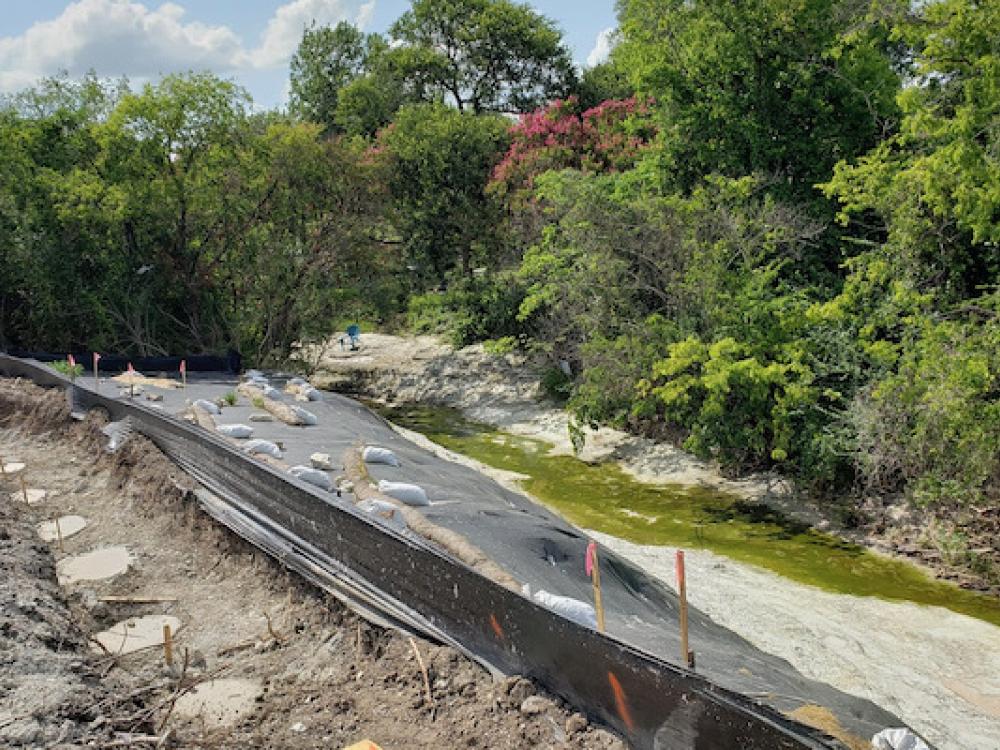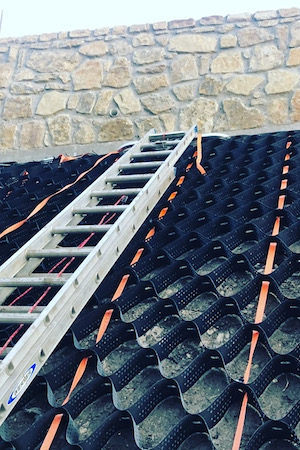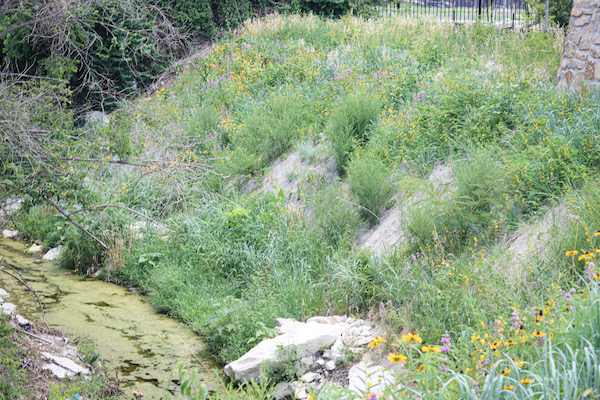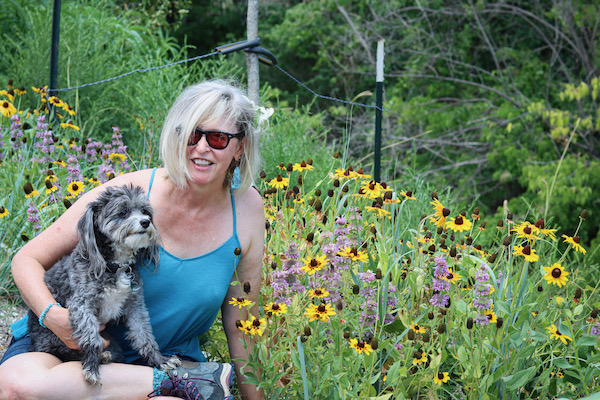Creek banks restored after Dallas neighborhood protests

Original post at https://greensourcedfw.org/articles/ash-creek-banks-restored-after-dallas-neighborhood-protests
This is Part 2 of the Ash Creek Renovation in East Dallas. To catch you up, the banks of a beloved neighborhood creek were clearcut last year by construction workers during a $69.28 million renovation to Bryan Adams High School in East Dallas.
Kristi Kerr Leonard, whose backyard backed up to the creek, was determined to save her green sanctuary. After Leonard alerted neighbors, environmental experts and officials to the destruction, she soon got action. Within two months, the subcontractor SEDALCO Construction Services announced that a water engineering firm, Cardinal Strategies, had been hired to restore the creek bank. Read Part 1 to learn how one woman set out to save a neighborhood nature sanctuary.
A proponent of process-based restoration, Jerry Sanders of Cardinal Strategies had a supreme challenge in the months ahead. Get plants to re-establish on a steep 45-degree or more slope in a thin layer of soil, now newly exposed to full sunlight and prone to drying out. By the fall of 2021, Sanders had full access to the creek bank.
In December, Cardinal bolted a geogrid deep into the soil to stabilize it. The flexible, polyester lattice is several inches deep. Over that was attached a geo-web honeycomb mesh to reinforce the steep bank, creating a secure texture for plants and seeds to establish. Silicon packets that absorb and release water pockets were set into the mesh.
Sanders filled the mesh with soil enhanced by minerals and beneficial bacteria and fungus. To encourage the soil to remain in place, another mesh made of coconut fiber, looking like coir on steroids, overlaid the geogrid and geo-mesh.

Working with native plant experts Randy Johnson and John Snowden, Sanders devised a planting plan that had to span from dry conditions at the slope top to periodically inundated terrain at the bottom. All plants had to be suited to grow on slopes with thin soil over rock. Planting began in February 2022.
NATIVE PLANTS TO THE RESCUE
Nursery plants anchored the geogrid greenery, with Johnson and Snowden growing the grasses. Wildflower and forb seeds filled out the planting scheme, including monarda (Monarda fistulosa) and Illinois bundleflower (Desmanthus illinoensis) from Native American Seed, based in Junction, Texas.
Layered in to germinate at unfolding times, the seeds were inoculated with mycorrhizal fungus, aiding in germination and enlivening the soil.
Powder-blue Alamo switchgrass (Panicum virgatum L) was assigned to hold down the creek edges with its mat of underground rhizomes, along with clumps of inland seaoats (Chasmanthium latifolium), both amenable to standing water.

Mid-slope favored tenacious sun-loving plants like emerald-green eastern gamagrass (Tripsacum dactyloides) and willowleaf aster (Symphyotrichum praealtum) adorned with tiny purple daisy-like flowers, both with monster rhizomes. Small woody plants like lead plant (Amorpha canescens) and aromatic sumac (Rhus aromatica) thrived where installed in some spots.
The top of the creek bank, where the soil was a bit deeper, hosted prominent wildflowers like common sunflower (Helianthus annuus) and Maximilian sunflower (Helianthus maximiliani), and big native grasses like upland switchgrass (Panicum virgatum) which grows in large clumps.
A natural creek bank would have a thick tangle of trees and shrubs shading the water. Now the area is sun-baked, planted with small trees on the edge that will take a decade to cast significant shade. There are no mature trees and understory to screen the brightly-lit school from neighbors. Essentially, a vertical prairie.

In the dirt held back by the retaining wall, DISD-employed SMR Landscape Architects planted a sparse array of young cedar elm, yaupon and ash trees (really, during an emerald ash borer infestation?).
Herbaceous plantings spaced far apart left the soil unshaded and prone to evaporation. Good riparian practice dictates this area should be thickly foliated with grasses and forbs to slow, absorb and filter polluted water flooding off parking lots before it reaches the creek.
A CREEK BANK RESTORED
Step 6: Follow it through to the end.
By June 2022, 16 months after the incident, Kristi Kerr Leonard’s vertical prairie is in full bloom, with Eastern gamma grass and purple coneflower (Echinacea purpurea) already gone to seed. Deluges in May and June led to exceptional growth.
It’s a stunning sight: mounds of colorful wildflowers accented by vertical clumps of strappy grasses, a delightful and somewhat wilted tangle of plants shading and supporting each other and pollinators. During his water-testing visits, Tony Adler, a monitor volunteer from Texas Stream who now tests Ash Creek for water quality monthly, counted a dozen species of native bees.
With the creek bank work almost complete, I’m with Leonard sitting in on a site meeting held on a hellaciously hot afternoon. Present are representatives from SEDALCO, including project manager Jeremy Smith, and DISD Construction Services, plus Sanders of Cardinal Strategies and Johnson, all of us in hardhats and sensible closed-toe shoes.

“I’m very pleasantly surprised,” says Johnson. “The plants are established, they rooted in well, and they’re going to seed now. Jerry’s team did a fantastic job on getting this thing right. The base setup is really where it all comes into play. But the plants are dry right now. You could lose the whole thing if you don’t rehydrate.”
Johnson notes that temperatures in the 100s are likely to continue and no rain is forecast. SEDALCO, the Bryan Adam contractor employed by DISD, didn’t install irrigation until three weeks after planting, acerbating the dryness, and then watering was not monitored.
A key issue becomes apparent: the irrigation timer had been stolen.
Much discussion ensues on various topics, including how to replace and secure the timer, how much and how frequent irrigation is needed to save the plants, solutions to sprinkler heads located where water gets blocked by plants, and in general who will do what.
Leonard points out that no one is taking notes. Only Sanders can recap the discussion.
Participants are trying hard to be cooperative, and Leonard is pleased with the quality of the restoration.
Being an interloper, I’m free to ask how this creek bank destruction happened in the first place. Two over-zealous SEDALCO backhoe operators are assigned blame, but Smith notes they were only doing as told: clear the creek bank for retaining wall construction.

I point out that the architectural plans approved by DISD Construction Services exhibit little regard for erosion by building too close to the creek, and a lack of concern for the neighbors by ripping out the greenery screening the brightly lit school from houses just yards away.
An additional issue is that construction employees from the bottom to the top seem to have ignored the inevitability of erosion, starting with not stabilizing the creek bank immediately after stripping it of greenery.
But the restoration is beautiful and even on this hot afternoon butterflies and bees are abundant.
Johnson interjects, “When’s the last time you heard this on TV? The pollinator-native plants relationship maintains all terrestrial ecosystems on Earth. We’ve got native grasses that host [larvae], which means insects lay their eggs on them to reproduce. There’s leaf chemistry in those specific plants that they can’t get anywhere else. Those guys keep us all alive. We’re right next to a school full of young people. Their future depends on this. We need to educate them.”
I concur. “This could be an outdoor classroom,” teaching about native plants, habitat restoration and preventative techniques, such as green stormwater management. Ecological restoration adds almost $10 billion to the economy each year, employing over 125,000 people, more than coal, timber or steel industries.
But only Johnson, Leonard and I are enthused by the idea.

As Johnson and I walk back to our cars, he points out plantings on the blazing hot western exposure of the new construction, set in a sloped bed between heat-retaining walls and pavement.
“This is cherry laurel. It needs shade. Over here is some Alamo switchgrass, which needs much more water than what’s beside it. When these plants fail, as they are bound to do, landscapers can say native plants don’t work. They need better training.”
THE TAKEAWAY: NOT ENOUGH LEONARDS
Leonard’s goal was not only met but done well: a restoration of her neighborhood’s creek bank. But had the community not complained and maintained continual pressure, it would still be a bare slope disgorging dirt into the creek. Without management, it would undoubtedly grow back in a bramble of invasives like privet and Johnson grass — a far cry from the decades-old American elm and bois d’arc destroyed by backhoes.
Leonard deemed promises by DISD Construction Services of “restoration of disturbed site conditions around the construction area” to be insufficient. She pressed for specific plans that addressed the creek bank. She made notes, kept lists and demanded meetings and updates. She showed up prepared and asked questions.
As a result, DISD is left with a big bill for renovations that taxpayers will ultimately foot, a cost that could have been avoided.
Leonard has grown children and is no longer spending her free hours caretaking for now deceased parents. Self-employed out of a home office next to the site, she was able to monitor and accommodate meetings. She’s well-connected, articulate and facile in communications. How many people would have the nerve and ability to do all that?

It begs the question. How often has this happened when there wasn’t somebody willing or able to tackle righting a wrong? How many creeks have been destroyed by senseless construction, banking on exactly that — no one able to speak out?
It all seems so business as usual.
Unless concern for erosion and respect for creeks becomes standard in construction, it will happen repeatedly. A quick scan of a Dallas map shows dozens of DISD schools along streams, all requiring renovation someday.
Leonard estimates around $8,000 in lost income fighting for her creek, a significant hit to her budget.
“Being the project manager for the biography of Texas’ greatest environmentalist, Ned Fritz, I have realized the tremendous sacrifice advocacy requires. Yet because I was a trained naturalist and aware of the consequences of creek destruction, I had no choice but to step up. But that meant foregoing hours of time and personal income,” said Leonard.
“How do low-income folks manage to advocate for nature in their communities?” continued Leonard. “They work such long and exhausting hours, so much time spent commuting. We know that in our city, there is a great amount of environmental injustice to these citizens. The destruction of Ash Creek was terrible, but my communities’ health was not in danger. Looking back on the 17 months (and counting) of effort I have put into advocating for a minor creek leaves me baffled and incredibly frustrated.”

And it’s not over.
Bryan Adams renovation, funded by a bond she and her neighborhood voted in favor of, is nearly complete. Riparian trees no longer screen exterior lighting from buildings that loom over the creek, bright enough to cast shadows in backyards.
“The lighting is really an issue for us. It’s on from 7 p.m. to 7 a.m. They’ve turned off two lights for us and the rest point down. But the inside gym lights are kept on overnight and shine like a spotlight into our windows. Break ins are the reason, but we don’t see how lighting up the gym or the creek and backyards helps with that. Plus, science has proven that bright lighting disturbs nocturnal wildlife and leads to migrating bird deaths.”
And the advocacy beat goes on.
RELATED ARTICLES
Creek clearcutting spurs Dallas neighbors into action
Arlington couple helped turn former nursery into nature park
‘Lights Out’ campaign is gaining momentum, say organizers
Residents got rid of Shingle Mountain. Is a park in their future?
LLELA crew dug into prairie restoration during pandemic
Stay up to date on everything green in North Texas, including the latest news and events! Sign up for the weekly Green Source DFW Newsletter! Follow us on Facebook and Twitter. Also check out our new podcast The Texas Green Report, available on your favorite podcast app.





